#Mooreville Formation
Explore tagged Tumblr posts
Text
Archovember 2024 Day 25 - Pteranodon longiceps
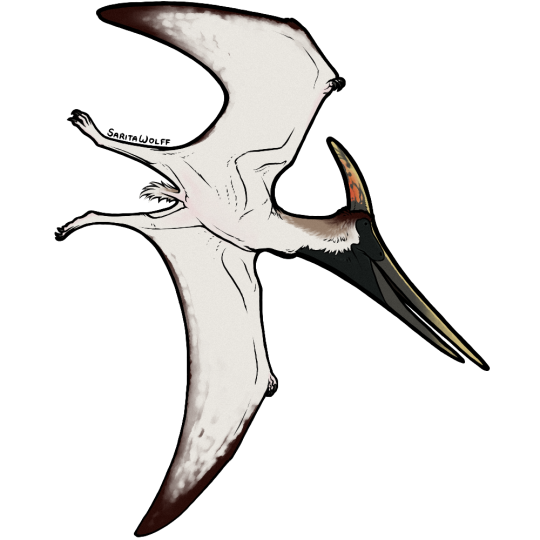
As one of the main species to make up the mythical “Pterodactyl” conglomerate, Pteranodon longiceps is possibly the most familiar pterosaur to the public. However, most people don’t know much about the real animal behind the pop culture monster. Living in the Late Cretaceous USA, Pteranodon is also the most well-known pterosaur to science, as over 1,200 specimens have been found! It was the first pterosaur found outside of Europe, the first toothless pterosaur found, and, before the discovery of the giant azhdarchids, was also the largest pterosaur known. Pteranodon is also one of the few prehistoric animals with confirmed sexual dimorphism, and it’s a bit extreme to boot! The larger male Pteranodons had huge pointed crests and an average wingspan of 5.6 m (18 ft), while the smaller female Pteranodons had small, rounded crests, wider pelvic canals, and an average wingspan of 3.8 m (12 ft).
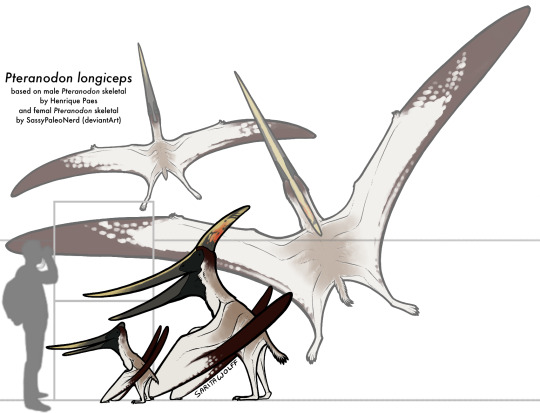
Pteranodon lived around the Western Interior Seaway, a massive sea that split North America in two during the Late Cretaceous into the Early Paleocene. With wings shaped like modern day albatrosses, Pteranodons were likely gliders who relied on thermals, but did seem to be more capable of sustained flapping. As one would expect, their diet was made up mostly of fish, though they may have eaten invertebrates as well. With their more heavy build, they could probably dive into the water like modern day gannets, folding up their wings and plunging beneath the waves, snatching up fish with their pointed, birdlike beaks. Pteranodon crests were most likely for display, as there was variation between not only males and females, but also individual males. As females were twice as common as males, they were probably polygynous, with males competing for the mating rights in rookeries of females. Competition was likely not physical, and instead would depend on females determining the age and fitness of males based on the size of their crest.
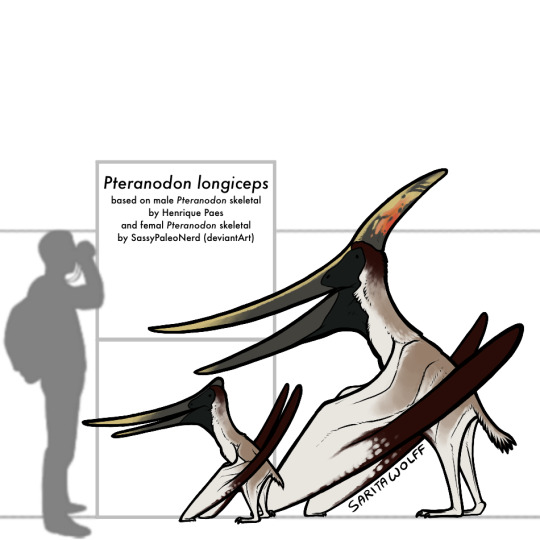
Pteranodon has been found in both the Niobrara Formation and the younger Pierre Shale Formation. Some possible fragments from the Mooreville Formation and Merchantville Formation also exist. While Pteranodon was much more common, it would have lived alongside, and possibly competed with, the fork-crested pterosaur Nyctosaurus and the toothed seabird Ichthyornis. It is probable that Pteranodon lived in offshore rookeries, raising their flaplings far from land-based predators, as most fossils are found far from what would have been the Interior Seaway’s coastline. Under the waves, Pteranodon would have hunted a variety of fish, ammonites, and squid. It would have come across sea turtles such as Toxochelys, plesiosaurs such as Styxosaurus, and flightless birds like Parahesperornis. It would have had to look out for mosasaurs like Tylosaurus and sharks like Cretoxyrhina. Aside from birds, most Pteranodons would rarely come across dinosaurs. Their main exposure to dinosaurs would be corpses, like that of the hadrosaur Claosaurus, being swept out to sea.

This art may be used for educational purposes, with credit, but please contact me first for permission before using my art. I would like to know where and how it is being used. If you don’t have something to add that was not already addressed in this caption, please do not repost this art. Thank you!
#Pteranodon longiceps#Pteranodon#pteranodontid#pterosaurs#archosaurs#archosauromorphs#reptiles#Archovember#Archovember2024#Dinovember#Dinovember2024#SaritaDrawsPalaeo#Late Cretaceous#USA#Niobrara Formation#Pierre Shale Formation#Mooreville Formation#Merchantville Formation
41 notes
·
View notes
Text

Dinovember 2024 Day 5: Hadrosaurus foulkii
This species, which measured 7-8 meters long, weighed about 2-4 tons, and lived about 80.5-78.5 million years ago on a coastal floodplain in what is now the Woodbury Formation of New Jersey, was in 1858 the first dinosaur ever to be described in the United States and North America from good fossil remains. Ten years later the only known specimen of Hadrosaurus foulkii became the first skeleton of a dinosaur ever to be mounted and put on display at a public institution-the Philadelphia Academy of Natural Sciences-by the renowned English naturalist-sculptor Benjamin Waterhouse Hawkins, who is also famous for designing the sculptures of dinosaurs and other prehistoric animals on the grounds of London’s Crystal Palace.
Hadrosaurus lends its name to the Hadrosauridae, the large, battery-toothed, herd-dwelling and hoof-toed ornithopods that dominated Laurasia and even Patagonia throughout the Late Cretaceous, and it was also part of a fauna of unique hadrosaurids that lived on the eastern Island continent of Appalachia. These included the 3-meter-long Claosaurus from the Niobrara Formation of Kansas, the basal Eotrachodon and the 4.5-meter-long Lophorothon atopus from the Moorevile Chalk Formation of Alabama, and the truly gigantic 10 to 17-meter-long Hypsibelma.
#paleoart#dinosaur#dinosaurs#paleontology#dinovember 2024#draw dinovember#dinovember#hadrosaurus#hadrosaurs#hadrosaur
76 notes
·
View notes
Text
Paper summary: Harrell et al., (2016). Endothermic mosasaurs? Possible thermoregulation of Late Cretaceous mosasaurs (Reptilia, Squamata) indicated by stable oxygen isotopes in fossil bioapatite in comparison with coeval marine fish and pelagic seabirds.
[This paper is freely available, by the way!]
Hi all! This is the first in a new weekly series I’m going to be doing, in which I will be doing a short paper review each Thursday. We’re starting off big this week, with a delve into the world of stable isotopes.
But Hayley, you say, what in the world are stable isotopes?
Okay, time for some backstory!
The part with the backstory
Isotopes, as you may be aware, are atoms of the same element that have different numbers of neutrons, and therefore different atomic weights. If you think back to chemistry class, or forward to chemistry class if you haven’t taken it, in which case this might help you get a leg up, you’ll remember or just be learning that each element is defined by the number of (positively charged) protons in its nucleus. So each atom of carbon has 6 protons, and if it has more or less, then that’s a problem, because then it’s not carbon. But within the same element they can vary in numbers of (neutral) neutrons. Neutrons are important for holding together an atom’s nucleus, because if you get a bunch of positive charges together in a nucleus they start to repel, just like if you get a bunch of elementary school-aged children together. Different isotopes act basically the same, and I can guarantee you that right now some of the carbon atoms you are using in your body have six neutrons, some have seven, and some have eight. These are referred to as carbon-12, carbon-13, and carbon-14, respectively, and that number refers to the number of (protons+neutrons) in the nucleus. [Sometimes some isotopes are unstable and undergo radioactive decay. Carbon-14 does this. But that’s not really relevant to what we’re doing today.]
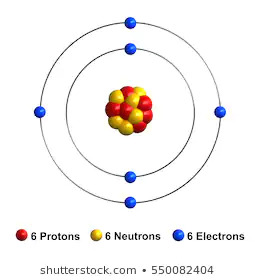
(Image: This is a carbon-12 atom. The yellow and red bits in the middle are the protons and neutrons. Not remotely to scale.)
Different isotopes of the same element act mostly the same (besides sometimes being radioactive and going berserk), so animals can take them up and use them. But they don’t act entirely the same, and that information can be used by palaeontologists to learn really cool stuff about past life.
A big thing that isotopes can do differently is something called mass-dependent fractionation. That’s fancy-people-speak for “it’s easier to move things that are less heavy”, and it means that it’s easier to move things that are less heavy.
One useful aspect of this deals with oxygen isotope fractionation. You are breathing oxygen as you read this, and if you are not then you will not likely be reading this for very much longer. Oxygen is also present in water, though, and water covers 70% of the Earth’s surface and makes up 70% of your body. It’s kind of a big deal, if you’ve never heard of it, and for our purposes it comes in two main flavours - water with oxygen-18, and water with oxygen-16.
Oxygen-16 makes up 99.76% of all oxygen on earth, and oxygen-18 makes up 0.2% (the rest is oxygen-17, which no one cares about). This means that about 0.2% of water is heavier than the rest of water. This water is harder to move, because it’s heavier, and when evapouration occurs, oxygen-16 is more likely to evapourate because it takes less energy to move it.
But wait! Putting in more energy makes it easier to move heavy things, and this is exactly what happens. If temperatures are warmer, more oxygen-18 gets evaporated than does at colder temperatures.
We need something to compare this to, because otherwise we’d just be measuring samples and it’d be hard to know what different numbers are referring to. For oxygen, we use the standard of Vienna Standard Mean Ocean Water, or V-SMOW. It’s not super important to know what that is.
What is important is delta notation: δ18O (delta-eighteen-O) refers to how different the ratio of oxygen-18/oxygen-16 is from the standard. We use the symbol ‰, “per mil”, which is fancy people talk for 0.1%, for this, because the differences are really little. +1‰ means that there’s 0.1% more oxygen-18 in the sample than normal - that is, it’s 0.1% “heavier” than normal water.
So, to get that all neatly said: Higher temperatures = More heavy water evapourates = the water that is left behind is lighter.
The part with the actual paper
Oh yeah, the paper! That’s why we were here. Okay, so mosasaurs were a group of big marine lizards (not dinosaurs) in the Cretaceous period. I wrote a little about them here. They looked kinda like this, and could get up to 17m/55ft long.

(Image: A mosasaur, a streamlined marine reptile with a large head, flippers, and a vertical tail fin. Image by Dimitry Bogdanov.)
Being lizards, mosasaurs have been traditionally thought to be cold-blooded - perhaps a reasonable assumption, as all living lizards are cold-blooded. However, it has been suggested various times in the literature as well as informally that mosasaurs may have been warm-blooded, owing to their assumed ecology as fast-moving pursuit predators and the fact that other marine reptiles have been demonstrated to be warm-blooded.
In order to quantitatively test this, teeth from three species of mosasaur from the Mooreville Chalk in Alabama were collected and analysed to find the isotopic composition of oxygen. We need a control sample, though, to ensure that some geological process or change in atmospheric oxygen won’t mess up our data by adding or removing some heavy oxygen. In order to do this, the authors also tested samples from fish, turtles, and aquatic toothed birds that lived at the same time and place. That way they could place the mosasaur fossils in a reliable context.
And the results they found are really interesting!
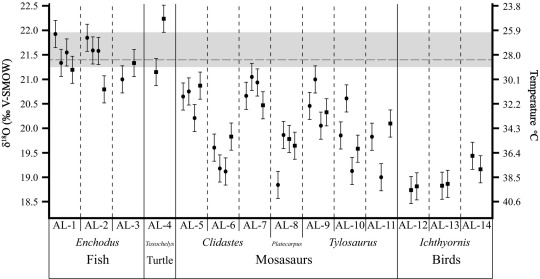
(Image: a graph showing δ18O values of different fossils from the Mooreville Chalk. I’ll do my best to explain what’s going on in the following paragraphs.)
Okay, so first things first. The fish and turtles tested have very similar δ18O values to each other. They both fall around the +21.2 to +22.0‰ range, or 2.12% to 2.2% heavier than “normal” water (because the “lighter” water has evapourated and left). This corresponds to a temperature of about 26-29°C (79-84°F). This is consistent with estimates of the temperature of the formation. This is what we expect from cold-blooded animals. Good! The method works!
Okay, next step. We can pretty safely assume that these birds were warm-blooded, and thus had a higher body temperature than their environment. Those tested had a δ18O value of about +18.5 to +19.5‰. That’s still heavier than normal water, but it’s less heavy than the cold-blooded animals (because the higher body temperatures led to more of the “heavy” water evapourating and leaving the body). This corresponds to body temperatures in the range of 36-39°C (97-102°F). This is right in the range of modern warm-blooded animals, and it’s another verification that the method works.
Okay, so what do the data say about mosasaurs? Well, it’s kind of a broad scatter. The δ18O values of the samples fall in the range of +19 to +21‰, which corresponds to a range 30-38.5°C (86-101°F). In other words, we’re getting body temperatures that are consistently warmer than the environment or cold-blooded animals, and in some cases are as warm as birds from the same environment!
What can we conclude from this? We can conclude that mosasaurs were probably warm-blooded, or, from the fact that some fall between the two, maybe “lukewarm-blooded” (which I wrote a bit about here). Either way, don’t think you’re safe just because it’s cold.
166 notes
·
View notes
Text
Ichthyornis dispar

By José Carlos Cortés on @quetzalcuetzpalin-art
PLEASE SUPPORT US ON PATREON. EACH and EVERY DONATION helps to keep this blog running! Any amount, even ONE DOLLAR is APPRECIATED! IF YOU ENJOY THIS CONTENT, please CONSIDER DONATING!
Name: Ichthyornis dispar
Name Meaning: Fish Bird
First Described: 1873
Described By: Marsh
Classification: Dinosauria, Theropoda, Neotheropoda, Averostra, Tetanurae, Orionides, Avetheropoda, Coelurosauria, Tyrannoraptora, Maniraptoriformes, Maniraptora, Pennaraptora, Paraves, Eumaniraptora, Averaptora, Avialae, Euavialae, Avebrevicauda, Pygostylia, Ornithothoraces, Euornithes, Ornithuromorpha, Ornithurae
Ichthyornis is one of the most famous not-quite birds, having been named a long time ago and known from fairly decent remains - so well known, in fact, that it, much like dinosaurs such as Archaeopteryx, Megalosaurus, and Iguanodon, is a taxonomic nightmare, and many other similar types of near-birds have had to be separated out from it as their own genera (such as Guildavis and Iaceornis). Still, in its own right, Ichthyornis is an interesting dinosaur, showing much about what the ancestors of modern birds were like. It was a small dinosaur, with a long snout - honestly, a ridiculously large head, when you really look at it - from the the Niobrara Formation of Kansas, the Mooreville Chalk Formation of Alabama, and the Austin Group of Texas. It lived about 93 to 83 million years ago, from the Turonian through the Campanian ages of the Late Cretaceous, making it a fairly common component of the Western Interior Seaway of North America at the time.

By Jack Wood on @thewoodparable
Though named “fish bird”, this was actually due to the vertebrae being considered similar to that of a fish (or considered to be so by Marsh, who described it), rather than due to the potential diet of Ichthyornis itself. Its short tail and toothed snout showed, at the time, an important step in the evolution of birds from their dinosaurian ancestors (though, admittedly, at the time scientists didn’t know their ancestors were dinosaurian). In addition to just having a weird head, it had a wingspan of greater than 60 centimeters, a body length of about 30 centimeters, without the length of the tail. It had a lot of teeth that were in the middle of the jaw behind a little beak at the front of it, and it also had long and robust wings that would have allowed it to soar over the large ocean it called home. Its short, slender legs would not have been used much in locomotion, though it wouldn’t have needed to, given that it probably spent most of its time on the air and floating on the water surface.

By Scott Reid on @drawingwithdinosaurs
Ichthyornis was probably very similar to a gull, diving into the shallow part of the water to catch fish, flying back out to the surface to soar above the sea. It got to be larger than the largest known modern gulls, though it also could be quite small, with a noticeable range of size known for the genus, however, these different sizes don’t seem to delineate separate species, and they probably are just growth stages of I. dispar or other potential species that can’t really be figured out via the fossils. They, thus, grew quite slowly compared to modern birds, which is surprising as they are so close to being modern birds. It lies just outside of the clade of Hesperornis and Neornithes, indicating that, perhaps, the ancestor of modern birds may have been an aquatic sort of dinosaur. This is, of course, under considerable debate, as it seems that the earliest Neornithes may have been terrestrial, as was Apsaravis. So, the jury is still out on that mystery.
Sources:
Martyniuk, M. P. 2012. A Field Guide to Mesozoic Birds and other Winged Dinosaurs. Pan Aves; Vernon, New Jersey.
Mayr, G. 2017. Avian Evolution: The Fossil Record of Birds and its Paleobiological Significance. Topics in Paleobiology, Wiley Blackwell. West Sussex: 88 - 90.
https://en.wikipedia.org/wiki/Ichthyornis
Shout out goes to @likeatreebesidetheriver!
#ichthyornis#ichthyornis dispar#bird#dinosaur#birblr#palaeoblr#likeatreebesidetheriver#paleontology#prehistory#prehistoric life#dinosaurs#biology#a dinosaur a day#a-dinosaur-a-day#dinosaur of the day#dinosaur-of-the-day#science#nature#factfile#Dìneasar#דינוזאור#डायनासोर#ديناصور#ডাইনোসর#risaeðla#ڈایناسور#deinosor#恐龍#恐龙#динозавр
67 notes
·
View notes
Text
Halimornis thompsoni
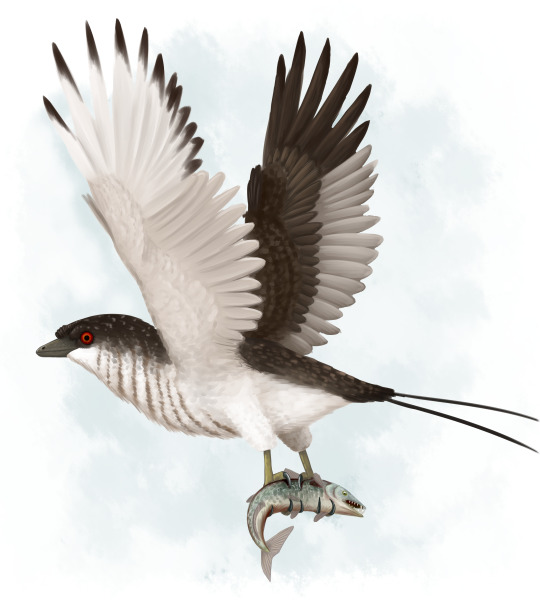
By Scott Reid on @drawingwithdinosaurs
PLEASE SUPPORT US ON PATREON. EACH and EVERY DONATION helps to keep this blog running! Any amount, even ONE DOLLAR is APPRECIATED! IF YOU ENJOY THIS CONTENT, please CONSIDER DONATING!
Name: Halimornis thompsoni
Name Meaning: Sea Bird
First Described: 2002
Described By: Chiappe, Lamb & Ericson
Classification: Dinosauria, Theropoda, Neotheropoda, Averostra, Tetanurae, Orionides, Avetheropoda, Coelurosauria, Tyrannoraptora, Maniraptoriformes, Maniraptora, Pennaraptora, Paraves, Eumaniraptora, Averaptora, Avialae, Euavialae, Avebrevicauda, Pygostylia, Ornithothoraces, Enantiornithes, Cathayornithiformes
Halimornis was an Enantiornithine from the Mooreville Chalk Formation of Alabama, which was on the coast of the Western Interior Seaway, which is what lead to this Enatiornithine’s name. It lived about 80 million years ago, in the Campanian age of the Late Cretaceous, and it was a small bird with an extensively long wingspan - a body length of 17 centimeters, but a wingspan of 40 centimeters. This ocean going species probably used its large wings to fly above the ocean and search for food there, given that its fossil was found very far away from the nearest shoreline; this is another unique adaptation for an Enantiornithine into a typically Euornithine niche. It had unique knees which probably would have allowed it to be good at swimming as well. It probably fed primarily on fish, and maybe other small birds on the ocean.
Sources:
Martyniuk, M. P. 2012. A Field Guide to Mesozoic Birds and other Winged Dinosaurs. Pan Aves; Vernon, New Jersey.
https://en.wikipedia.org/wiki/Halimornis
Shout out goes to @tiniest-jo!
#halimornis#halimornis thompsoni#bird#dinosaur#palaeoblr#birblr#tiniest-jo#paleontology#prehistory#prehistoric life#dinosaurs#biology#a dinosaur a day#a-dinosaur-a-day#dinosaur of the day#dinosaur-of-the-day#science#nature#factfile#Dìneasar#דינוזאור#डायनासोर#ديناصور#ডাইনোসর#risaeðla#ڈایناسور#deinosor#恐龍#恐龙#динозавр
55 notes
·
View notes